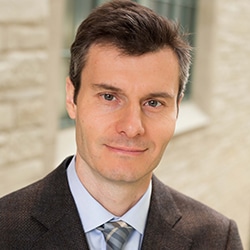Apr 12 2019
Examining the movement of minute cells is not an easy task. For chromatin, the group of RNA, DNA, and protein macromolecules packed within genome, motion is an essential part of its active role as a regulator of how human genes get repressed or expressed.
 Vadim Backman. (Image credit: McCormick School of Engineering, Northwestern University)
Vadim Backman. (Image credit: McCormick School of Engineering, Northwestern University)
“Understanding macromolecular motion is critical, but scientists know very little about it,” said Vadim Backman, Walter Dill Scott Professor of Biomedical Engineering at Northwestern Engineering. “Part of the reason is because we lack instrumental techniques to observe those processes.”
Now, a study team at the McCormick School of Engineering guided by Backman has formulated a new optical method to explore the movement of cells without using dyes or labels to monitor them. The groundbreaking technique has also exposed an undiscovered occurrence that may play a role in the initial stages of cell death.
The team’s findings were published in the April 10th issue of the journal Nature Communications. The paper is titled “Multimodal interference-based imaging of nanoscale structure and macromolecular motion uncovers UV induced cellular paroxysm.”
While researchers can presently monitor the movement of cells using molecular labels or dyes, the practice has its restrictions. Dyes are lethal and modify the performance of cells before, ultimately, killing them. Labels are stuck to cells, can be lethal or cause photobleaching, and may change the motion of the same molecules they label.
The new method, known as dual-PWS, is label-free and can image and compute macromolecular motion without the need for dyes. Based on a quantitative imaging method formulated earlier by Backman called Partial Wave Spectroscopy (PWS), the platform uses the interference and pattern variations from backscattered light to track both the macromolecular structure of cells together with their dynamic movement.
Critical processes like the transcription of a gene or the repair of damaged proteins requires the movement of many molecules simultaneously within a highly packed, complex environment. As an imaging platform with the capability to measure both intracellular structure and macromolecular dynamics in living cells with a sensitivity to structures as small as 20 nm with millisecond temporal resolution, the dual-PWS is uniquely suited to allow us to study these processes.
Scott Gladstein, Study First Author and PhD Student, Backman’s lab, Northwestern Engineering.
The scientists applied dual-PWS by examining the nanoscale structural and dynamic variations of chromatin in eukaryotic cells in vitro. Using UV light to trigger cellular death, the team calculated how the movement of the cells’ chromatin was altered.
“It makes sense that as cells are about to die, their dynamics lessen,” Backman said. “The facilitative motion that exists in live cells to help express genes and change their expression in response to stimuli disappear. We expected that.”
What the scientists did not anticipate was to observe a biological occurrence for the first time. A cell reaches a “point of no return” during deterioration, where even if the source of the cellular damage is halted, the cell would be incapable of repairing itself to an operational state, Backman said. Using dual-PWS, the scientists noticed that just before this turning point, the cells’ genomes burst with rapid, instantaneous motion, with various parts of the cell moving apparently uncoordinated.
Every cell we tested that was destined to die experienced this paroxysmal jerk. None of them could return to a viable state after it took place.
Vadim Backman, Walter Dill Scott Professor of Biomedical Engineering and Head of Center for Physical Genomics and Engineering, Northwestern University.
The team is uncertain why or how the occurrence, known as cellular paroxysm, happens. Backman initially speculated if the movement could be because of ions entering the cell, but such a process would have taken very long. The uncoordinated motions of the cellular structures happened over milliseconds.
“There’s simply nothing in biology that moves that fast,” Backman said. He added that members of his lab were so astonished by the results, they jested that the occurrence could be described as “Midichlorians” leaving the cell, a reference to the chemical personification of “the Force” in the Star Wars films.
While cellular paroxysms remain unidentified for the time being, Backman feels the team’s findings show the significance of exploring the macromolecular behavior of live cells. The more insights scientists can get about chromatin, the more probable they can soon be able to control gene expression, which could revolutionize how people are treated for diseases like Alzheimer’s and cancer.
Every single biological process you can imagine involves some sort of macromolecular rearrangement. As we expand our research, I can’t help but wonder, ‘What will we find next?’
Vadim Backman, Walter Dill Scott Professor of Biomedical Engineering and Head of Center for Physical Genomics and Engineering, Northwestern University.
Northwestern Engineering’s Guillermo Ameer, Daniel Williams Hale Professor of Biomedical Engineering, and Igal Szleifer, Christina Enroth-Cugell Professor of Biomedical Engineering, also contributed to the study.
Cellular Paroxysm
This time-lapse video compares the structural and dynamics (fractional moving mass) response in control cells in the left column to cells irradiated with UV in the right column. Cellular paroxysm can be seen in the top right quadrant, after about 11 minutes of UV irradiation. (Credit: McCormick School of Engineering, Northwestern University)